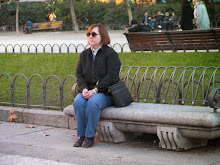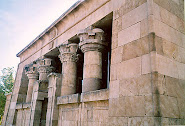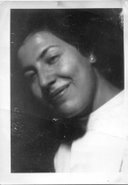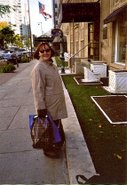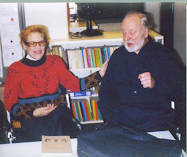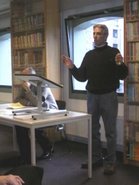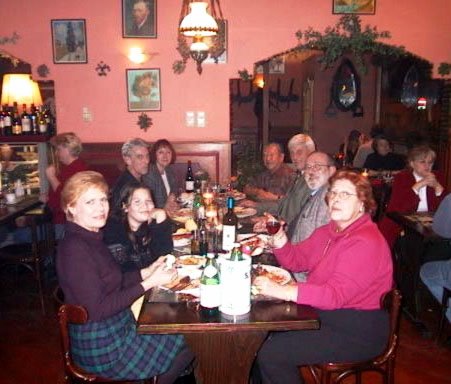
How grateful I am that any of these magnificent tomb paintings have survived since c. 1500 BCE, and how sad I am that antiquities robbers destroyed so much of their beauty for money. Irreplaceable heritage and history destroyed forever and hacked out of the 'living rock' of our memories for a few lousy bucks. A pox and a curse on the houses of those people who dealt in and continue to deal in such iniquity! I am really GLAD the man who destroyed Nebamun's tomb died on the streets of London a pauper.
Photo: Nebamun, his wife and daughter on board a skiff, during a hunting trip. For colours, the unknown 'Michelangelo of the Nile' would have used soot, desert stones and ground glass Photograph: Corbis (Notice the cat, sort of "floating" at the knees of Nebamun, helping herself to the plethora of birds! Cats - invariably female - were Egyptian symbols for female sexuality and the recreative force, embodied in such goddesses as Bast (Bastet) and the powerful and ancient lioness-headed Sekhmet (Sakhmet), an aspect of equally ancient goddess Hathor (Het-hert), often depicted as a cow-headed woman. In later depictions, Hathor was depicted as a woman sporting long cow horns with the Sun resting in-between, and often confused with renditions of Isis.)
Raiders of the lost art
They are ancient Egypt's greatest tomb paintings, yet they were created for a middle-ranking official by an unknown artist. As the Nebamun panels go on display in the British Museum, Robin McKie reveals a tale of exquisite craftsmanship and a 3,500-year-old tabby cat
Robin McKie
The Observer, Sunday 4 January 2009
Enter the British Museum's new Egyptian gallery and you will be struck by a line of painted panels of unexpectedly rich colouring and extravagant composition. On one panel, a pair of naked female dancers, their fingers interlaced, glide sinuously before a crowd at a banquet. Beside them, a flute player stares out from the painting, her hair shimmering as if she is swaying to the music. Each figure is distinct, individual and freely drawn, their proportions and detail captured perfectly.
Wander further along the main wall and you will find other exuberant depictions of everyday life in 18th Dynasty Egypt: a boy driving cattle along a road; geese, stored in baskets, ready for the market; a farmer, stooped and balding, checking his fields, and a hunt through reed beds that burst with creatures - shrike, wagtails and pintail ducks - easily identifiable still.
These are the tomb paintings that once belonged to Nebamun, a court official who lived almost 3,500 years ago, and they are the greatest surviving paintings we have from ancient Egypt. Each was created for Nebamun by a painter as gifted as any of the Renaissance's finest artists, and they will be revealed to the public this month when the British Museum opens a special gallery dedicated to them, a 10-year project that has cost £1.5m to complete. It will be a striking addition to the museum.
Yet for all the effort that has gone into the gallery's construction and the studies of its paintings, mystery still shrouds the Nebamun panels. For a start, archaeologists have no idea about the identity of the artist who created them and are equally puzzled why a painter of such talent was involved with a relatively minor clerk like Nebamun.
Nor do historians have any record of the original tomb's location. The man who discovered them was a Greek grave robber called Giovanni d'Athanasi, who dug them up in Thebes, as Luxor was then known, and then passed them on, via a collector, to the British Museum. However, in 1835 D'Athanasi fell out with curators over his finder's fee and refused to divulge the precise position of the tomb. He took his secret to the grave, dying a pauper in 1854 in Howland Street, a few minutes' walk from the museum. Ever since, archaeologists have searched in vain for the tomb of Nebamun and any treasures that it may still contain.
The Nebamun paintings have - to say the least - a colourful history, and the task of unravelling it, and for caring for these remarkable works, has been handled by Egyptologist Richard Parkinson. Dapper, bow-tied and possessed of an infectious enthusiasm for his subject, Parkinson showed me the panels last November, when they were cased in wood and glass, ready for removal to their new gallery. They were stacked in a museum basement store which held other Egyptian artefacts, including a series of panels dedicated to a chief treasurer, Sobekhotep. Think of him as the 18th Dynasty's answer to Alistair Darling, a politician who controlled the nation's wealth and economic destiny. Yet the panels commemorating him are thin, lifeless and provide little feeling for the man's life or times, or any sense of artistic sensitivity.
By contrast, the artwork that celebrates Nebamun's life bursts with energy. In one panel, he stands on a papyrus skiff at the head of a hunting trip into reed-covered marshes filled with tilapia and puffer fish, Egyptian red geese, tiger butterflies, black and white wagtails and an exquisitely painted tawny cat that is helping itself to the birds being brought down by Nebamun. The cat is a product of particularly grand draughtsmanship, in which stripes and dots have been delicately assembled to produce a magnificently whiskered tabby. Scales on fish, feathers on ducks and soft folds in the clothes of the Nebamun retinue have also been created this way. It is an extraordinary evocation of Egyptian life, its vitality undimmed 3,500 years later. As for Nebamun, in the hunting panel he towers over proceedings, his wife Hatshepsut beside him and their daughter at his feet. Wearing a black wig and a great collar of beads, he strikes a pose that is assured and proud, almost regal.
Yet Nebamun was really just a bean counter - or to be precise, a grain counter whose job was to make sure the wheat stores in the temple of Amun were properly controlled. So how did this middle-grade civil servant acquire the services of one of the greatest painters of ancient Egypt while his superiors had to make do with second-rate artists?
"These are the greatest paintings we have from ancient Egypt," Parkinson says. "There is nothing to touch them in any museum in the world. Yet they were created for an official too lowly to have been known by the pharaoh. It is quite extraordinary." Parkinson does, however, have an intriguing explanation. The "Michelangelo of the Nile" who created these great tomb panels was almost certainly working on another project in the neighbourhood of Nebamun's tomb at the time. This building or burial complex would have been constructed, and decorated, on a far grander style for a far more important figure. Nebamun merely slipped the artist and his team some extra cash and they stole off to paint his own panels. In short, the secret of his tomb and its great painting lies with one word: backhanders. "Life then was not that different from today," says Parkinson.
Ironically, the artist's main project was no doubt a finer work, but it has disappeared, looted and trashed like the vast majority of ancient Egypt's great treasures. The Nebamun panels are the only record we have of this genius. We have therefore good reason to be grateful to Nebamun, one of life's perennial opportunists, but an astute collector of fine art just the same.
As to their purpose, the paintings were intended to make Nebamun appear important in the afterlife. They would have covered the tomb's upper level, while his body was interred in a chamber below ground. Friends and family would have visited the upper part of the tomb, left gifts and held feasts to commemorate Nebamun's life. "This was where life and death merged," says Parkinson. Thus the paintings were not buried and hidden away but established a link between the living and the dead. Hence their importance to Nebamun's family. They were to be appreciated, leisurely, after the man's death as reminders of his achievements.
They were certainly not created at a leisurely rate, however, as Parkinson has found in his investigations of the paintings. Once the tomb's stone walls had been erected, they were covered in straw and Nile mud mixed together into a squishy paste. Then, when this was dry, a thin layer of white plaster was added. As that started to dry, the artist and his team began to paint, using soot from cooking pots, desert stones for red, yellow and white pigments, and ground glass for blue and green. Rushes, chewed at the end, would have acted as brushes. Squashed into the dark, narrow upper tomb, the painters would have had to work by lamplight before the plaster dried. The results are almost impressionistic in the freedom of their execution.
"I think Nebamun had all his paintings done for his tomb-chapel walls in three months," says Parkinson. "Yet the draughtsmanship was quite wonderful. The thing is that although the artist and his team may have done them in a few weeks, I have now spent a quarter of my life studying their handiwork."
The panels' importance to modern eyes is clear. They tell us a great deal about ancient Egypt and its everyday activities, and about differences and similarities between life then and now. "The straw crates in which geese are sold at market - you see these on just about every street corner in Cairo," says Parkinson. "And the women's jet-black hair and skin colour are just the same as we see in Egypt today."
However, Parkinson warns about drawing too many parallels between modern life and the scenes depicted in the panels. Objects and animals are often included because they had great symbolic importance. That great hunt scene is more than a depiction of everyday life: the birds and cat are symbols of fertility and female sexuality, and Nebamun's expedition can also be seen as "taking possession of the cycle of creations and rebirth", as one scholar has put it. Certainly, visitors should take care when trying to interpret the panels' meaning.
Nevertheless, the paintings repay detailed inspection. On several of them, you can see where d'Athanasi's grave robbers had started to crowbar a panel from a wall only to find it cracking, ready to split. They would then move on to splinter open the panel at a new spot. "Only 20 per cent of the panels survived these attacks," adds Parkinson. "Only sections that would appeal to British audiences were taken: the ones with naked dancing girls and scenes from gardens. Perfect for our taste, in short."
One or two other fragments did end up in other
museums, including several that are now kept in the Egyptian Museum in Berlin. Evidence also suggests that a handful of fragments may survive elsewhere. For example, records from the Cairo Museum show that, just after the second world war, a few sections from the tomb were about to be exported from Egypt, a move that was opposed by its government - so officials had the panel pieces photographed and stored in the great vaults below the Cairo Museum. And that is where they rest today, though their precise location has been lost. All that is known is that among the tens of thousands of other ancient treasures kept in the museum's store, the missing Nebamun panels are today gathering dust in a dark, lost corner. It is a strange fate and it invites - irresistibly - a comparison with the fictional resting place of the Ark of the Covenant, dumped in a mammoth warehouse at the end of Raiders of the Lost Ark. In short, a fantastic end for some fantastic art.
 Anyway, back to the optical illusions. The first shot is at the main entry into the hotel lobby where guests check-in. It is a bit dark - I'm too tired tonight to do photo-stuff to try and lighten it a bit - anyway, the spectacular astrolabe is not the primary subject of the photo, it's the floor! Take a look at it. dondelion's photo captured a lady walking gingerly across what appear to be raised planks!
Anyway, back to the optical illusions. The first shot is at the main entry into the hotel lobby where guests check-in. It is a bit dark - I'm too tired tonight to do photo-stuff to try and lighten it a bit - anyway, the spectacular astrolabe is not the primary subject of the photo, it's the floor! Take a look at it. dondelion's photo captured a lady walking gingerly across what appear to be raised planks!
 The second photo was taken at the end of a long promenade from the check-in area toward the casino. On one side are exclusive shoppes, on the other side are windows looking out onto the grounds of the hotel and the busy sight of limos, cars and taxis pulling in and out. Where the casino begins, the marble flooring ends and plush carpeting takes over. Shades of Escher! You also get a very good view of the lushly painted vaulted ceiling over the promenade.
The second photo was taken at the end of a long promenade from the check-in area toward the casino. On one side are exclusive shoppes, on the other side are windows looking out onto the grounds of the hotel and the busy sight of limos, cars and taxis pulling in and out. Where the casino begins, the marble flooring ends and plush carpeting takes over. Shades of Escher! You also get a very good view of the lushly painted vaulted ceiling over the promenade.

































